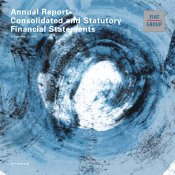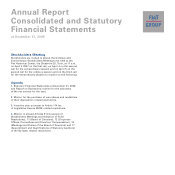Chrysler 2006 Annual Report Download - page 10
Download and view the complete annual report
Please find page 10 of the 2006 Chrysler annual report below. You can navigate through the pages in the report by either clicking on the pages listed below, or by using the keyword search tool below to find specific information within the annual report.
Report on Operations Research and Innovation 17
Research and Innovation
Report on Operations Sustainability Report – Economic, environmental and social responsibility16
Now in its third year, the Group’s Sustainability Report attests
to the importance that Fiat assigns to full, open disclosure,
not just of the information that demonstrates financial
accountability, but in terms of social and environmental
responsibility as well.
The 2006 Sustainability Report is the result of the Group’s firm
commitment to achieving the kind of reporting that best
reflects its organisation and the needs of its stakeholders:
a commitment that grows stronger with every passing year.
Thus, the prize for the year’s best reporting initiative that FERPI,
the Italian Public Relations Federation, conferred on the Group’s
Annual Report in 2005 did more than reward the efforts of all the
people at Fiat who share this commitment: it spurred them to do
better, and demonstrate that the praise that was well-earned then
is still richly deserved. This is one of the reasons that the 2006
Sustainability Report, though continuing the work done in
previous years, introduces several major changes. They are
changes designed to meet several key needs: the need to
increase inclusiveness by reaching out to all of the Company’s
stakeholders and speaking a language they can all respond to;
the need to let analysts and opinion leaders know how well the
Company measures up in such important areas as corporate
social responsibility and ethical finance; the need to follow
Global Reporting Initiative guidelines even more closely.
To enable stakeholders to gauge the Group’s contribution to
sustainable growth, the Report illustrates the work done during
the year from the standpoint of its economic, environmental
and social impact. After presenting the 2006’s
accomplishments, the measures introduced to promote
greater stakeholder engagement, and an overview of the
Company’sorganisation and corporate governance structure,
the Report uses the three-dimensional Triple Bottom Line
approach to measure its work against performance
indicators that go beyond classic financial reporting criteria.
As such, it is divided into three sections, where information
is grouped according to the stakeholders concerned in order
to ensure greater clarity.
As the section on economic responsibility illustrates, Fiat
continued to focus on value creation and boosting the
Group’s financial ratings and competitiveness, putting the
customer square at the centre of its growth strategies and
partnering with other major international groups.
In the section on environmental responsibility,the Group
provides a comprehensive view of its attention to ensuring
sustainable manufacturing practices at its production plants
and to developing products with the lowest impact on
the environment by reducing energy consumption, cutting
emissions and increasing efficiency. In addition, the section
illustrates research work carried out and its applications
on environmentally-friendly mobility and traffic safety.
The section on social responsibility scrutinises the Group’s
relationship with its worldwide workforce and the public. This
section provides details and statistics about employees and
hiring policies, as well as discussing the initiatives promoted
in favour of young people, health and safety, equal
opportunities, education and training and employee benefits.
The section concludes with a description of the Group’s
community outreach efforts, including programs for helping
people with physical disabilities retain their mobility.
The Report is posted in the Sustainability section of the
Group’swebsite at www.fiatgroup.com, where stakeholders
are invited to provide their feedback regarding the Company’s
corporate social responsibility by filling in the questionnaire
or sending e-mails at [email protected].
Sustainability Report
Economic, environmental
and social responsibility
Centre’s global innovation strategies, ensures that it can
implement specific operations at the local level, and helps
it create skills and monitor its competitiveness and growth.
Further information is available on the Centre’s website at
www.crf.it.
The work of the Centro Ricerche Fiat focuses on several key
areas of technology.
Powertrain Research and Technology
The major objective in this field is to develop and apply
innovative technologies for improving powerplant performance,
cutting engine and vehicle emissions, and boosting fuel
economy. The Centro Ricerche Fiat’s most significant
accomplishments for 2006 in this area are reviewed below:
■Multijet II.As part of Fiat Powertrain Technologies R&D
efforts, predevelopment work on the new Multijet II diesel
injection system was completed in 2006. This system is able to
manage the multiple injection process developed for the earlier
Multijet without the latter’s limitations on the distance between
successive injectors, thus bringing significant performance
benefits. The high-pressure pump was also redesigned,
reducing significantly costs.
■Two-cylinder spark ignition engine.Alongside Multiair
electronic valve control technology, downsizing is another
stepping stone in Fiat Powertrain Technologies’ strategic path
towards achieving minimal CO2emissions. Thus, work is now
concentrating on developing small supercharged engines that
can replace naturally aspirated powerplants with larger
displacements. In 2006, the first version of a supercharged
two-cylinder Multiair engine was developed, and prototypes
were put through their paces in an array of bench and
on-vehicle tests that assessed their potential in terms
of performance, fuel economy and noise emissions.
■Panda Hydrogen.For all of the intense effort that has gone
into development and testing, hydrogen powered vehicles
plying our streets and highways are still a long way in the
future. But with an eye to that future, the Fiat Group
is concentrating on small, fuel cell city cars: the Seicento
Elettra H2 Fuel Cell unveiled in 2001, the Seicento Hydrogen
To promote sustainable mobility on multiple fronts, the Fiat
Group has organised its research and innovation work through
two companies, the Centro Ricerche Fiat (Fiat Research Centre)
and Elasis, whose strategies are coordinated by the Technical
Committee of the Group Executive Council.
In 2006, the Group’s research and development expenses1
amounted to approximately 1.6 billion euros or around 3.2%
of net industrial activities. Overall, R&D activities involve some
13,200 people at 116 centres.
Centro Ricerche Fiat (Fiat Research Centre)
The Centro Ricerche Fiat provides the Group with effective,
innovative solutions at competitive prices, ensuring smooth
technology transfer by further increasing the professional
qualification of personnel through training. This enables
the Centre to play an active role in supporting technological
growth for the Fiat Group, its partners and the communities
where they work in such fields as motor vehicles and
componentry, energy, safe and environmentally-friendly
mobility, telematics, innovative materials and relevant
technologies, mechatronics and optics.
In particular, the Centre’s work in innovative powerplants,
alternative propulsion systems and transmissions
is conducted through Powertrain Research and Technology
headed by Fiat Powertrain Technologies, the Fiat Group Sector
set up in May 2005 which groups together all of the Group’s
activities in this area.
In addition to its headquarters in Orbassano on the outskirts
of Turin, the Centro Ricerche Fiat has four branches in Bari,
Catania, Trento and Foggia, as well as a controlling interest
in the C.R.P. Plastics and Optics Research Centre in Udine,
whose work focuses on advanced research in the field of optics
and plastics for automotive lighting systems. With a staff
of 870 employees, the Centro Ricerche Fiat made significant
progress during the year, as witnessed by the 61 new patent
applications it filed in 2006, bringing the total number of
patents held by the Centre to over 2,100. A further 900 patents
are currently pending. In addition, the Centro Ricerche Fiat
was awarded 128 projects in the EU’s Sixth Framework
Program, confirming its leadership in European research. The
Centro Ricerche Fiat cooperates with over 150 universities
and research centres, and more than 750 industrial partners
around the world. This network further strengthens the
(1) Includes capitalised research and development expenses and those charged directly against income for the year.























